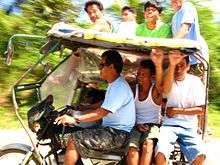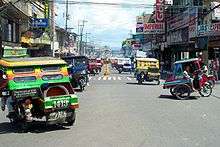Motorized tricycle (Philippines)
Motorized tricycles, or simply tricycles (known in the rest of the world as a motorcycle and sidecar), are an indigenous form of the auto rickshaw and are a common means of public or private transportation in the Philippines. These public utility vehicles either ply a set route or are for-hire, like taxis. The Boracay Budget Travel website says of the motorized tricycle, "The tricycle is the most popular means of transport in small towns and cities, especially in the rural areas."[1]


Tricycles are built in a variety of styles, which differ from city to city, and are usually made locally by building a sidecar and affixing it to an imported motorcycle. Usually both the cycle and sidecar are covered, but not always by the same roof. Larger companies, such as Fitcor Marketing, also manufacture passenger tricycles.[2] They are built with more seats with the motor situated at the back, rather than below the driver as per a motorcycle.
Origin
The exact date of the appearance of the tricycle in the Philippines is unknown, but it started appearing after World War 2, roughly at the same time as the appearance of the jeepney. It is most likely derived from the Rikuo Type 97 military motorcycle used by the Imperial Japanese Army in the Philippines starting at 1941. The motorcycle was essentially a licensed copy of a Harley-Davidson with a sidecar.[3] However, there is also another hypothesis which places the origin of the tricycle to the similarly built "trisikad", a human-powered cycle rickshaw built in the same configuration as the tricycle. However, the provenance of the trisikad is also unknown. Prior to the tricycles and trisikad, the most common means of mass public transport in the Philippines is a carriage pulled by horses or carabaos known as the kalesa (calesa or carromata in Philippine Spanish).[4] The pulled rickshaw never gained acceptance in the Philippines. Americans tried to introduce it in the early 20th century, but it was strongly opposed by local Filipinos who viewed it as an undignified mode of transport that turned humans into "beasts".[5]
Passenger tricycles
Passenger tricycles can accommodate from four passengers up to as many as six or more, excluding the driver.[6] Goods can be placed on the roof. One or two passengers can sit behind the driver while several more can sit in the sidecar, depending upon the design. Additional passengers can sit on the roof or stand hanging onto the side or back of the sidecar. In rainy weather, a tricycle will be completely enclosed in heavy plastic covering.
Tricycles can be painted colorfully, like jeepneys.
Fares are less than taxi fares (if the city or municipality has taxis), yet more expensive than jeepney fares. Fares range from P10 to P250, depending on the locality and the distance to be ridden. Inside cities, tricycles often operate as shared taxis, where passenger fares are calculated per passenger and after the distance traveled. These fares are close to the fares of jeepneys. For longer journeys or in areas with heavy tourism, the driver will usually request that the passenger hire the whole tricycle and negotiate a "special fare", which will then be a private hire.[2]
Many tricycles, mostly in urban areas, are now being replaced with a local version of tuk-tuks which has superior engines and seating space. While technically not a tricycle as its private versions are not forbidden in national roads, they are treated as advanced versions of tricycles and deployed as such.
Another take of the upgrade to better tricycles is the one undertaken in the City of Manila. It is fully electric and distributed by a local company with major Japanese partnership.[7][8]
Motorela
The motorela, locally nicknamed as "the mini jeepney", is a variant of a motorized tricycle used in Northern Mindanao, particularly in Cagayan de Oro City and Bukidnon province. It is a motorcycle with an enclosed cabin rigidly attached, and has four wheels – the two wheels of a motorcycle, and an additional wheel on each side. It has the capacity to carry more passengers than the traditional tricycle. The motorela was invented by Rafael D. Floirendo, a mechanic from Cagayan de Oro, in 1964.[9][10] Motorela comes from the words “motorized” and “caritela”.[11]
Cargo tricycles
Cargo tricycles are also used in the Philippines and elsewhere in Asia. The cargo tricycle either has a bed in the back or on the side as a sidecar.[12]
External links
![]()
References
- Boracay Budget Travel website, "Archived copy". Archived from the original on June 30, 2012. Retrieved April 27, 2013.CS1 maint: archived copy as title (link) ; William C. Pollard, Jr., email to Lonely Planet, November 1, 2010, p. 2.
- Greg Bloom; Michael Grosberg; Virginia Jealous; Piers Kelly (May 2009). Philippines. Lonely Planet. p. 450. ISBN 978-1741047219.
- "The History of the Philippines Tricycle". Brits in the Philippines. Retrieved March 25, 2020.
- "Filipino Icon: Tricycle and Pedicab". FFE Magazine. December 29, 2016. Retrieved March 25, 2020.
- Pante, Michael D. (August 14, 2014). "Rickshaws and Filipinos: Transnational Meanings of Technology and Labor in American-Occupied Manila". International Review of Social History. 59 (S22): 133–159. doi:10.1017/S0020859014000315.
- "Tricycles in Sorsogon". Sorsogoncity.wordpress.com. July 11, 2011. Retrieved November 11, 2015.
- http://www.bemac-philippines.com/en/updates/news-from-the-web/66-e-r-a-p-manila-electric-tricycle-project-second-batch-of-beneficiaries-ready
- "Tricycle Guide". Monday, April 29, 2019
- "Tricycle, Motorela & Habal-Habal". Silent Garden. 2015. Retrieved November 11, 2015.
- "Cagayan de Oro Transportation". cdoguide. January 26, 2009. Retrieved November 11, 2015.
- "Raphael Floirendo – the Motorela Inventor". www.CDODev.Com. March 18, 2010. Retrieved November 11, 2015.
- Alibaba.com website.